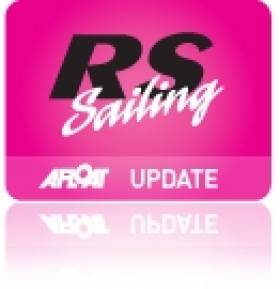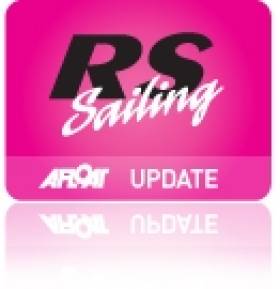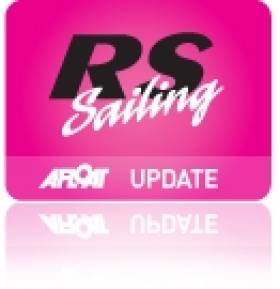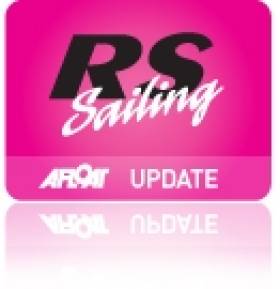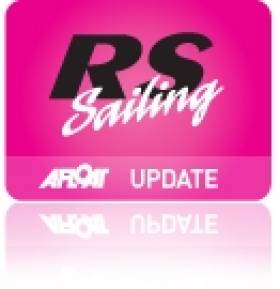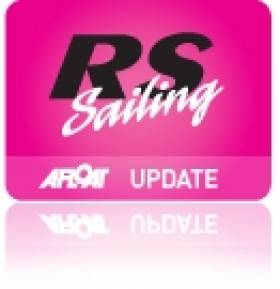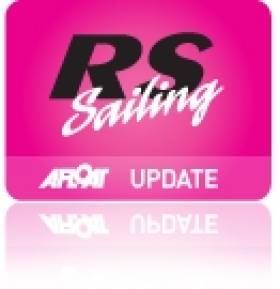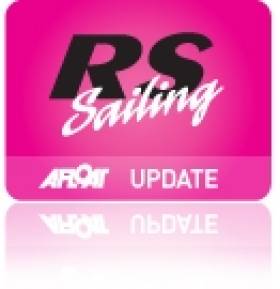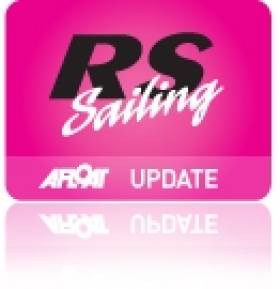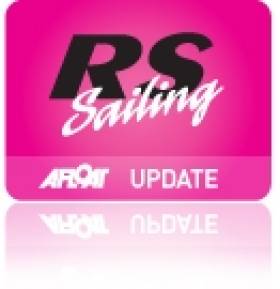Displaying items by tag: RS Sailing
#rssailing – Greystones Sailing Club has long been the Irish home of the RS fleet writes Sarah Byrne. In the late 90s, the formerly vibrant Enterprise fleet was looking around for a new toy and found the fast, furious and responsive RS400 enjoying an enthusiastic take-up in the UK following its launch in 1994.
When the RS200 was then launched many of the Greystones RS400 sailors opted for the sister boat which still provided the adrenaline packed racing 'responds to finesse rather than physique' (RS Sailing) with a greater flexibility of competitive crew weight.
In 2009, building on feedback from youth sailors, the RS double-hander pathway at GSC was defined with the RS Feva, RS200 and RS400 now providing a seamless transition and a boat for all combinations of skills and crew weights.
With over 55 asymmetric boats now in the Club, it must be the top asymmetric Club in the Country.
Following successful frostbites series on Belfast Lough and in Dun Laoghaire and some training in Cork, many sailors new to the fleets will be making their first voyage in what is forecast to be perfect conditions for an early season outing with PRO Neil Murphy on hand to ensure great racing on a trapezoid for the three fleets.
Irish Feva & RS Dinghy Class Associations Merge
#rsfeva – Following successful events together last year the RS Feva is now joining the RS200 and RS400 classes under the Irish RS Class Association umbrella. This makes the three classes a true double-hander pathway much as the Laser is for singlehanders.
The Feva/200/400 pathway caters for all ages and weights to compete and socialise at the same events.
The Irish season kicks off shortly with the Easterns at Greystones, April 12/13th and a Training event will be announced soon.
The Feva Europeans are on this year in Bruinesse, Holland from May 29th – 31st and the Worlds are on in Carnac, France from 25th July to 1st August.
Two excellent and accessible venues and a great opportunity to get up to speed before the Crewsaver Irish RS Nationals in Galway starting Friday 8th August.
RS Aero Weighing in at 30kg Lifts-Off at RYA Dinghy Show
#rsaero – After several years of development testing four different hull variations and numerous rig, foil and layout options, RS Sailing unveiled what could become one of the most important new sailboats of this era at the Suzuki RYA Dinghy Show in London – the RS Aero.
In many ways you can think of the RS Aero as a 21st century Laser – with the most fundamental difference being ultra-light weight. A full size single hander that, amazingly, weighs 30kg - the same as an Optimist.
Every dinghy sailor can imagine how that changes the game. Sail the boat and you quickly realise you underestimated it. From the exhilaration on the water, to the sheer user-friendliness ashore, the RS Aero re-sets preconceptions: The rush as the boat accelerates - the ability to carry it up the beach single-handed – the convenience of youths or small women lifting it onto a roof-rack with ease.
Ultra-light weight means the hull form and rigs need not be extreme, so the RS Aero is utterly exciting without being hard to handle. Wide structural gunwales give a dry ride and make the boat quick and safe to right from capsize.
A three rig system, as per the Laser, has been envisaged from the start to cover the desired sailor range – RS Aero 5 (youths) – RS Aero 7 (women & light men) – RS Aero 9 (men). All spars are carbon fibre, with a common top mast and boom for all sails and radically different stiffness lower mast sections. The hull is so light that even the Aero 5 has a higher sail area to weight ratio than most existing single-handers and retains the Aero's incredibly dynamic feel.
Two v4 pre-production prototypes were on the RS Sailing stand at Alexandra Palace and caused a storm, with crowds around them all weekend and people lifting the boat and laughing out loud at the surprise. Final stages of the development process are underway, with every aspect of this simple boat having been examined, developed and tested for functionality over fashion, minimal weight, maximum strength and manufacturing efficiency. Perhaps the most remarkable achievement of the RS Aero is that despite being half the weight, built using epoxy resin and significant amounts of carbon fibre in the hull and all-carbon spars, the price will be close to that of a Laser.
UK roll-out of the RS Aero will take place first and a demo tour begins next weekend. Orders are now being taken with a special launch price available on the first 100 boats – well over half of which have already been reserved.
All through development, the reaction has been similar. From weekend warriors to discerning professionals, the RS Aero re-ignites passion for sailing in its purest, least complicated form. With RS Sailing's global distribution network, worldwide success seems assured.
RS CAT16 Wins Awards
#rssailing – The RS CAT16 was launched in September and is already the winner of two prestigious sailing industry awards in the USA. Sailing World magazine has voted the RS CAT16 it's "Dinghy of the Year" and Sail magazine announced the boat as "Small Multihull of the Year".
These awards reflect the fantastic reaction from everyone who has seen and sailed the CAT16, including professional boat testers and experienced sailboat fleet operators, in Europe as well as North America. Initial impressions have been great, with the RS CAT16's unique new assembly technology and game-changing design features. Once afloat the usual comments are that the boat feels much stiffer than expected of a rotomoulded catamaran and performs beautifully – quick, responsive and manoeuvrable. It simply does all that you want from a boat of this type...and more.
Constructed from RS Comptec PE3 rotomoulded construction system, using the highest quality polyethylene materials, the RS CAT16 will be highly durable making it particularly suited to training and beach centre use. The easy and sparkling handling also makes the boat ideal for recreational sailors and on the pathway to high performance catamaran racing.
Rig options include mainsail and jib only, a gennaker and single or twin trapezes. So whatever your aspirations, the RS CAT16 can be specified to match.
The RS CAT16 is the first multihull in the RS Sailing range and is available around the world via the RS Dealer network. You can find full details of the boat at www.RSsailing.com and locate your nearest dealer on the website's World Dealer Finder.
You can also see the RS CAT16 on the RS Sailing stands at the London and Dusseldorf Boat Shows in January.
Should Santa Bring You an RS200 or an RS400 This Christmas?
#rssailing – This year has seen explosive growth in the RS400 fleet with steady growth in the RS200. Up to a dozen 400s and half a dozen 200s have been bought since the end of the summer. This should make next years "Crewsaver" RS Nationals in Galway Bay even bigger than this years! With so many people looking to the sibling RS 200s and 400s currently, Heather Craig, Secretary of the RS Association, decided to seek some impartial advice to help prospective buyers decide which version best suits their crew weight and aspirations. Heather currently sails a 200 (the family own two) although she has competed in the 400 in the UK. So she spoke to Pete Vincent, previous chairman of both the UK 200 and 400 associations and active campaigner in both RS boats down the years. Heather asked "What weight bands would you advise for sailing a 200 and 400 for a sea sailing circuit and what are the issues for crews who are at the edges of these bands?"
Pete Vincent says:
"I was chairman of the whole RS Association so can speak with authority!! I am also one of the few who has properly raced 200 and 400's with the same crew. You can race a 200 successfully easily on the heavy side but only very few people can race a 400 successfully on the light side and the majority light suffer badly. I raced the 200 with Trudie and Tess at 22.5 stone (143kg) combined weight and had numerous top 10 overalls at 200 Nats; also won the Irish, but would not dream of doing the 400 Nats with Trudie/Tess. Trudie tells a funny story of doing a 400 open, trying to pump the kite and hitting the shroud as she was pulled forward along the side deck. Heavy weights can learn how to sail the 200 in light airs and have a real advantage upwind in the 14-20 knot wind let alone when it gets proper breezy. The 400 is such a grunt boat for light crews once there is any sort of pressure; they are just blown away up wind without being able to remotely gain it back down wind. Once it is proper breezy the light weights do not have the physical presence to sail the boat properly downwind in waves. The other major problem with the 400 for lighter weights is that the kite is very intimidating for the faint hearted crew who is also usually the smaller person so it becomes physically very draining for the small crew. I sailed the 200 Nats last year and the 400 Nats this year with the same crew. We were lucky at 400 Nats that it was generally light/medium winds."
Pete mentions Tom Hewitson (ex uk rs200 nationals winner x 2) so I caught up with him too. Here was his contribution on the subject ;
"I would say 200 optimum is 19-23 stone (120-146 kgs) combined weight. Can carry the heavier weights with spreader settings, rake etc. RS 400 23-28 stone (146 – 177kgs) is optimum. Jo and I sailed 400s at 21 stone (133kgs), we were quick in light airs at sea or up to medium winds inland. But it's not enough really, bearing in mind at that stage we were very fit, circuits 2-3 times per week and sailing 3 out of 4 weekends and we still struggled."
So there you have it. If you are considering buying please try them both in a breeze to make sure you get it right for you and your crew. Contact Heather at [email protected] to arrange either a one to one or club try out in either of these boats and she will arrange that for you.
RS Feva, RS200 & RS400 Inlands at Blessington Sailing Club
Rssailing – With all forecasts promising a chilly Northerly force 4 with gusts up to a 6 the RS extended family descended on Blessington for the last event of 2013 Irish RS Circuit. Crews were welcomed at registration with cakes & hot chocolate. Outside, boats were hastily unpacked, rigged and tuned as fingers became numb.
Layers, hats and the odd drysuit were donned in anticipation of the colder water of the lake and thoughts of a cold night camping for the hardier crews. A thorough briefing was given by Race Officer Barry O'Neil detailing the 'no go shallow areas of the lake'. The committee boat even went to the trouble of showing the sailors exactly where the bottom was. After a brief pit-stop on the sand the committee boat was soon on its way again. After launching and clearing the shallows the thirty boats had swift blast down the lake to the race area.
In The RS Feva class it was the local team of Alison Dolan & Grainne Young who dominated proceedings scoring an impressive five wins from six races. The local lake sailors showed their salty rivals how to do it fresh water style. Triona Hinkson & Katherine Kelly were the best of the rest in 2nd place with a 4 point margin over third place Lorcan Tighe & Cian Murphy.
A reduced fleet of RS400's enjoyed belter of an event. A few new pairings and formidable experienced crews enjoyed some of tightest racing of the season. Four boats shared the same score after discards at end of race 6. With the series allowing for up to eight races and things running so efficiently the Race Officer decided to run a 7th race. This put final order on the results.
The 7th race developed into an epic match race between Sean Cleary & Steve - STAAAAARBOOARD!!!!!! Tyner, Versus Emmet Ryan & new crew Luke "Laser" Murphy. Despite some very impressive crew work and trimming by young Murphy and chucking the kitchen sink at them down the last run, Cleary & Tyner held on for a deserved first traveller series win.
Now that the Irish 400's are up to speed with lake sailing the 2014 RS Euro Cup in Lake Garda should be a piece of cake! But Blessington will be hard to beat.
Among the 200s were a few new pairings: Lisa Smith with Megan Hayes, sister of her usual crew looking at the gusty conditions with glee tinged with a touch of trepidation as one of the lightest boats. Maeve Rafferty took the 'old man' on board for Saturday and Meg Tyrell, an experienced Feva sailor was looking forward to her first spin in a 200 with Sarah Byrne.
Young Aaron Jones set the early pace and led around the first loop of the trapezoid, however at the leeward mark, his outhaul come off the boom – and no duck-tape to hand. In all very close racing was had on day one with places changing as often as the wind direction. Trevor Fisher/Emily Watt and Steven Craig/Conor Foley both showed good speed in the conditions but it was father son team Frank & Kevin O'Rourke who found the groove winning the first 2 races. Race 3 upset the trend and Roy Van Maanen got to the front keeping the chasing fleet at bay.
The O'Rourkes slept peacefully on just four points leaving fellow Greystones team Roy Van Maanen/Glen Reid on 8 points with the young George team of Stephen Craig/Conor Foley overnight. Father and daughter Graeme/Katie Noonan closely following on 11 points along with Trevor Fisher and Emily Watts from East Down YC.
On Day two, Roy and Glen forged ahead in the leading pack to take the next three races, but not without a struggle. Race 6 was a particular interesting affair with the whole fleet bunched at the start of the last run. Picking the right line downwind and the approach to the leeward mark was critical.
Race 7 started with just one point separating the two Greystones boats Van Maanen/Reid and the O'Rourkes. At the first mark, both boats rounded in the back half of the fleet having gone right up the beat, but the O'Rourkes went left and Van Maanen stayed out right pulling ahead little by little, making the third lap leeward rounding in the lead but losing two places on the final reach to the finish with youngsters Stephen Craig/Conor Foley pulling ahead with National duo Conor Totterdell/Myles Kelly in close pursuit. The final results had Roy and Frank tied on equal points with Roy winning on count back and taking the Inlands trophy home, the O'Rourkes finished second but took the Irish RS200 Circuit trophy for their season's efforts and Stephen Craig and Conor Foley came in third just missing out on the Circuit trophy by half a point.
Looking ahead, at least 6 RS200's and 6 RS400's are expected at this year's DMYC Frostbite series. Numbers continue to grow up North with up to 15 RS400's expected at the RNIYC and Ballyholme winter series.
The RS Association have already put together a provisional calendar for 2014 hoping to start in April with a Munster event coupled with a try out session for the 200s in Cork Harbour. Any clubs interested in looking at the RS Boats as a potential double hander 'Club Pathway' from 6- 66 years, please contact Sarah Byrne (087 235 8489) to arrange a try out session in your Club.
No Sunshine But Cork Harbour Delivers the Goods for RS Fleets
#RSSailing – A fleet of 10 RS400s gathered for the Southerns, with several significant teams missing such as last year's National Champions Emmet and James Ryan from RStGYC, Ryan Seaton and Matty McGovern, back on the Olympic 49er campaign, Mike Ferguson and Jeremy Tomalin from Ballyholme and Team Artemis, and the majority of the RNIYC fleet save for DrC and Stevie Kane. This gave a few teams the chance to focus on toppling this season's top duo of Dr Bob SP and Mike G. Sadly for the rest, the current hotshots swiftly gave them a good seeing to, with a trio of runaway victories on Day 1, with only local Monkstown man and top 505 driver Alex Barry, teaming up with fellow Monkstowner Dave Doherty, to chase them down, as the rest struggled to come to terms with the ripping tides on the spring tide weekend. Indeed the new pairing demonstrated a potent turn of speed, after some sneaky two boat tuning with Royal Cork's Aidan MacSweeney. This just went to show that Dave's "old yellow boat" was anything but slow, cementing a strong second place overnight.
As the freshly beaten crews rushed off to Cronins for some of Ireland's finest Guinness and Seafood Chowder, a critical three way protest hearing was being played out, which would have a dramatic though ultimately irrelevant effect on the overall standings. Multiple Irish Champion Garrett Flannigan from Ballyholme, sailing with Dave Fletcher, was flicked as a result of some leeward mark chaos, though by the time he got to Cronins, no-one understood what the issue was, and a jovial night's craic ensued. Mature heads managed to limit the damage, leaving the event leaders to make a few poor decisions at the RCYC Bar late in proceedings, and come out for Sunday's racing having lost some of their polish.
With the tide now pointing in the opposite direction, and a large ship parked just upwind of the windward mark, opportunities were aplenty to throw it all away, and the Bangor duo set about doing just that. Whilst Simon Herriott and Tom Moran (aka Sprinkles) from Greystones chipped away with another couple of podiums, the big story was a turbocharged challenge from Flannigan, who was clearly giving it some Ben Ainslie, and promptly yotted past everyone downwind with a rude turn of speed, to take bullets in races 4 and 5, with some ease. Witnessing this performances, SP and Gunning decided to see who else was racing and sailed round at the back of the fleet, posting a "shocker" in race 5, to make it game on again.
So race 6 set off with DrC winning the pin for the first time in his illustrious 35 year campaign, and Garry Flannigan tacking into some oncoming traffic or similar. Sadly this mirrored precisely Race 5, only the wrong way round for Gary, as the win he needed to match with SP having a 5 or worse, was in fact reversed, and SP took the gun and the whole shebang, whilst Flannigan disappeared out the back, having to settle for runner up. The 400 is an unforgiving mistress!
Great fun altogether, and especially good to see Dave Doherty and Alex doing so well, only missing out to Dr C and Steve on countback for the bottom step of the podium. Hopefully these guys will form the nucleus of a new planned Cork based contingent and give us an excuse to come back here again in future, to one of Ireland's most beautiful venues.
Like the 400s, the 200s arrived in Cork on Friday evening quite an eclectic but incomplete bunch... we were missing our usual head of the fleet boats but knew there would be healthy competition with Stephen Craig and Conor Foley from the George who, although comparatively new to the fleet, made their mark at the Nationals coming in fifth overall, the Greystones pair Conor Cleary and Aaron Jones who have spent so much of their summer on the water and Lisa Smith and Kate Hayes who are soooo good downwind. After a summer of light wind events we were all really looking forward to some screaming reaches....
On Saturday we woke to very calm conditions. We waited for an hour after the briefing and it began to pick up a little.... So we headed out for the long reach North to find some depth in Cork harbour and race 1 began as the tide was on the turn.
First up wind leg was a jostle for places and there proved to be chopping and changing throughout the race. But race one belonged to the young guns with Royal St George's Stephen Craig and Conor Foley pulling ahead on the second downwind leg, maintaining their lead to the finish. They were followed by Greystones' Conor Clery/Aaron Jones in second with Sarah & Molly Byrne narrowly taking third from fellow Greystones sisters Rachel & Sarah Hoolahan
A calmer start for the second race, those choosing to go right made gains out of the tide. Mother daughter team, Sarah and Molly lead from the start with Conor and Aaron slipping back throughout the race and RStGYC daughter/father pairing Clodagh & Adrian Hinkson taking second with Gabrielle Igoe/Trish Clery in third and Stephen and Conor in fourth.
Race 3 began with all boats very close up the beat. Stephen Craig and Conor Foley took the lead early but found it difficult to shake off Lisa Smith/Kate Hayes and Conor Clery/Aaron Jones for two laps leaving quite a stretch between them and the following fleet. However on the third lap Sarah & Molly Byrne gradually picked off boats to round the windward in second in a very strong tide and slackening breeze. Lisa Smith's supremacy downwind ensured she snuck ahead before the final leeward mark rounding as both boats caught up with Stephen and Conor who had found a hole. All three rounded the mark in quick succession with Sarah/Molly forced to tack off into the tide immediately. However, they just managed to cross the two boats before the finish but Stephen got ahead and Sarah/Molly only just managed to tack and pip Lisa/Kate to the line in a sudden unexpected gust sneaking in around the Committee Boat as the Hoolahans watched the close finish from fourth place. Overall there was very close racing up and down the fleet, leaving Royal St George pairing Stephen Craig/Conor Foley and Greystones Sarah & Molly Byrne on equal points overnight but the George boat with two firsts. A protest from race three later forced Lisa Smith/Kate Hayes to lose their best result of the day before the party started.
Sunday dawned to a very calm Cork Harbour and a long sail out to Cuskinny. Greystones boats, Sarah/Molly and Lisa/Kate chose the pin end to start, going left and led up the first beat. Very close downwind racing and some admirable sportsmanship from Lisa, allowed the Byrnes to sneak ahead and take the first, Lisa and Kate second with the young guns from the George taking a third.
With the discard, the Craig/Foley George duo and Greystones Byrnes were still on equal points. The next two races were confidently led by the Hinksons who had really got in to their stride with Stephen Craig and Conor Foley successfully covering the Byrnes to maintain their lead and in the process managing to take another two bullets and first overall, the Byrnes second and the Hinksons third. The finish of race six had the first five boats round the last mark in quick succession and finish within a minute...... a testament to the close racing over the weekend across a diverse mix of crews in terms of gender, age (16-50) and weight (couldn't possibly comment)– a very 200 finish!
In the RS Feva class, the Royal Cork's Luke McGrath and Eoghan O'Regan won the first race in what was their first outing in the boat but were soon ousted by RCYC Jill McGinley and Maeve O'Sullivan who in spite of a split jib, won the 2nd race. Monkstown's Luke Fehilly and Shane Dunlea took the last race of the day with Monkstown Bay's Martha Fehily and Jenny O'Leary also performing well on Saturday with two seconds in the bag.
On Sunday, Jill and Maeve, armed with a new jib, dominated day two for the Fevas to win the event with another 3 bullets. Luke and Eoghan remained consistent to claim 2nd place overall and Monkstown's David Hyland and Charlie Moloney came in third.
We didn't get the sunshine nor the signature RS screaming reaches the forecasts had promised, but the superb race management more than made up for it with three fleets on the same course and all races sailed. Huge thanks to PRO Peter Crowley and his efficient team, Rear Admiral Darren O'Keeffe, Feva Class captains Rory Fitzpatrick and Ed Rice and the extended team at RCYC for a really good event, camping facilities, yummy food and a great welcome.
We look forward to the last event of 2013 for the Irish RS Classes, the RS Feva RS200 and RS400 Inlands hosted by Blessington Sailing Club on the 12th and 13th of October. Early entry discount closes Friday 4th October.
RS CAT16 Catamaran Launched at Southampton Boat Show
#RSCAT16 – Last Friday RS Sailing unveiled the first ever RS Catamaran - the RS CAT16 at the Southampton Boat Show. The weather gods were kind and the stand was buzzing with eager listeners sharing a glass of fizz and watching an RS CAT16 sailing on the water and listening to RS Sailing Managing Director Martin Wadhams introduce the newest addition to the RS Range.
The RS CAT16 will have its North American debut at the Annapolis Sailboat Show in the USA in early October and you can see the boat at many International Boat Shows over the coming months, including Paris, Dusseldorf and Amsterdam.
Production will start later this year and orders are being taken now.
RS Fleet Season Finale Set for Dun Laoghaire on Saturday
#RSSAILING – As has become a tradition in the RS200 and RS400 fleets in Ireland, the final showdown of the season will take place this weekend in the confines of Dun Laoghaire's Harbour walls, with a crash bang wallop series of races, comprising the RS Sprint Trophy.
This is essentially a programme of single lap races, over a square course, with barely enough time to catch a breath, let alone pop and drop a kite. Obviously the emphasis is on boat handling and heads out of the boat, as the usual 90 degree shifts in the harbour can make one's track very short, or very long, depending on how you go about it!
The usual suspects will be there from the two asymmetric fleets, with a few new owners keen to make an entrance, but probably hoping to spare a few blushes too...
All good fun and games, and the weather looks perfect, so why not pop down to the harbour to see the fleets in action.
Matters commence at 11am, and run throughout the day to the final rounds late afternoon.
NI Dragon Champion Challenges for RS Elite Title in Cowes
#rselite – Belfast lough's Simon Brien who won last month's Dragon class Edinburgh cup on home waters is switching boats to challenge for the RS Elite Nationals in Cowes next week.
Hosted by the Royal Yacht Squadron in Cowes with the forty boat fleet moored in their harbour next to the Castle, the setting could hardly be better. This alone would make the occasion stand out for many sailors who've read in awe about the Club and the prestigious regattas they've hosted through their illustrious history.
Competition is always tight and the biggest ever fleet of these one-design keelboats will only make it closer. Five past Elite Champions have entered, a number of other Elite owners who've held National titles in other classes and virtually every RS Elite class Cowes Week, Scottish Series and Irish Nationals winner will also be on the start line! It's hard to know where to start trying to pick favourites for the 2012 title.
Jono Brown in Aeolus from Burnham is the defending champion – Brien in Kin from Northern Ireland recently won the Dragon Edinburgh Cup in his other boat – Crauford McKeon in Kandoo III from Lymington dominated at the previous biggest Elite championship in 2010 – Shaun McClean in Elixir from Scotland won in 2009 and was runner-up last year.... The list goes on... It will take tactical consistency and the best boat set-up to produce what it takes to win in all conditions for this one.
And there is another factor - RS Elite sailors enjoy the craic and there is a fantastic social programme throughout the regatta. Add sponsorship by the superb Wight Vodka, inevitable rounds of wonderfully drinkable cocktails and their slogan of "tack and gybe responsibly" will be highly salient! The social side of the event means everyone will have a good time no matter what the outcomes on the water. "The reputation of the RS Elite fleet's competitive racing and high-energy socials has gained incredible momentum" says Ritu Manocha of Wight Vodka. "We are psyched to be associated with such a dynamic group of individuals!"
RS Elite sailor and event director Charlie Egerton-Warburton from the Royal Yacht Squadron says "The stage is set for an exhilarating 2012 RS Elite Championships. Our club is really looking forward to welcoming RS Elite sailors from across the country, indeed globe. Seven of the forty entrants are associated with Island clubs, and thus we are making steady progress towards our objective of establishing a large Elite fleet around the Island. Importantly, we have worked hard to infuse the regatta with an Island theme throughout, not least of course via the generous title sponsorship of my personal favourite Wight Vodka. We wish everyone a wonderful regatta."




























